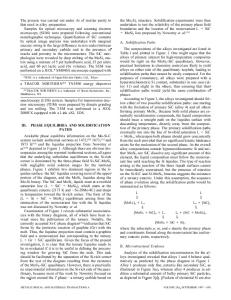Solidification of particle-reinforced metal-matrix composites
- PDF / 960,683 Bytes
- 9 Pages / 612 x 792 pts (letter) Page_size
- 67 Downloads / 426 Views
I.
INTRODUCTION
METAL-MATRIX composites (MMCs) are a class of advanced engineering materials in which a strong ceramic reinforcement is incorporated into a metal matrix to tailor its properties for specific applications. The most commonly used reinforcements are silicon carbide, graphite, and alumina particles and fibers. An economical processing route to make silicon carbide particle-reinforced aluminum alloy MMCs has been developed by Alcan, based on the melt stirring technique for particle incorporation. This process typically involves stirring approximately 15-/zm SiC particles into an aluminum-silicon alloy melt with a suitable mechanical stirrer. Following particle incorporation, the molten composite can be cast by various methods, such as investment casting and squeeze casting. Indeed, the potential for widespread use of MMCs stems from their flexibility to smoothly adapt to existing foundry practice for near-net shape casting. The solidification process is a crucial step that largely determines the pattern of particle distribution and microstructure of the solidified MMC which, in turn, influence many of the properties of the MMC. Solidification of particle-reinforced MMCs can depend on factors solely attributable to the presence of inert ceramic particles in the melt, such as particle settling or flotation, leading to local variations of particle volume fraction and thermophysical properties of the melt, as well as interaction between the particles and solidification front. The latter is mainly determined by the solidification rate and the morphology of so-
G.S. HANUMANTH, Research Associate, and G.A. IRONS, Dofasco/NSERC Professor of Process Metallurgy, are with the Department of Materials Science and Engineering, McMaster University, Hamilton, ON, Canada LSS 4L7. Manuscript submitted May 9, 1995. METALLURGICAL AND MATERIALS TRANSACTIONS B
lidification structure and may lead to particle capture by the front in some cases and to particle pushing in others. Both settling and particle-front interaction during solidification may significantly influence the distribution pattern of the particles in the solidified MMC. A large body of work exists on the interaction of a single inert particle with a planar solidification front and the determination of the critical from velocity above which particle capture is expected to occur. The distortion of the plane front due to thermal conductivity mismatch between the particle and melt and its implication in particle pushing have been addressed by several authorsY -51 The morphology of the solidifying front can change in the situation where the particle ahead of the front forms a physical bartier to solute diffusion, which leads to a solute buildup behind the particle. A qualitative discussion of this phenomenon and its effect on particle pushing is offered by Sekhar and Trivedi.I61 A comprehensive summary of the preceding topics is available in a recent state-of-the-art review by Mortensen and Jin.[7] Other related studies have dealt with the mixing and settling of c
Data Loading...











